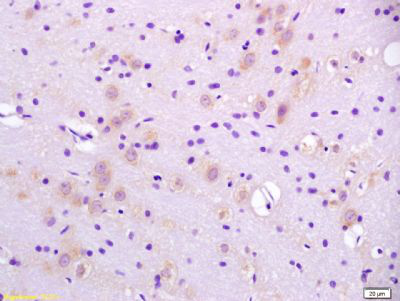產(chǎn)品貨號 : mlR6709
英文名稱 : CaIPLA2
中文名稱 : 胞漿鈣獨(dú)立磷脂酶A2抗體
別 名 : group VI iPLA2; 85 kDa calcium independent phospholipase A2; 85 kDa calcium-independent phospholipase A2; CaI PLA2; CaI-PLA2; CaIPLA2; Calcium independent phospholipase A2; Cytosolic calcium independent phospholipase A2; Group VI phospholipase A2; GVI; GVI PLA2; INAD1; iPLA(2)beta; iPLA2; IPLA2 VIA; iPLA2beta; NBIA2A; NBIA2B; PA2G6_HUMAN; PARK14; Patatin like phospholipase domain containing 9; Patatin like phospholipase domain containing protein 9; Phospholipase A2 calcium independent; Phospholipase A2 calcium independent group VI A; Phospholipase A2 group VI; Phospholipase A2 group VI cytosolic calcium independent; PLA2; PLA2G6; PNPLA9; PLPL9_HUMAN.
研究領(lǐng)域 : 信號轉(zhuǎn)導(dǎo)
抗體來源 : Rabbit
克隆類型 : Polyclonal
交叉反應(yīng) : Human, Mouse, Rat, Dog, Pig,
產(chǎn)品應(yīng)用 : WB=1:500-2000 ELISA=1:500-1000 IHC-P=1:400-800 IHC-F=1:400-800 IF=1:100-500 (石蠟切片需做抗原修復(fù))
not yet tested in other applications.
optimal dilutions/concentrations should be determined by the end user.
分 子 量 : 90kDa
細(xì)胞定位 : 細(xì)胞漿 細(xì)胞膜
性 狀 : Lyophilized or Liquid
濃 度 : 1mg/ml
免 疫 原 : KLH conjugated synthetic peptide derived from human CaIPLA2/PLA2G6:651-750/806
亞 型 : IgG
純化方法 : affinity purified by Protein A
儲 存 液 : 0.01M TBS(pH7.4) with 1% BSA, 0.03% Proclin300 and 50% Glycerol.
保存條件 : Store at -20 °C for one year. Avoid repeated freeze/thaw cycles. The lyophilized antibody is stable at room temperature for at least one month and for greater than a year when kept at -20°C. When reconstituted in sterile pH 7.4 0.01M PBS or diluent of antibody the antibody is stable for at least two weeks at 2-4 °C.
PubMed : PubMed
產(chǎn)品介紹background:
The protein encoded by this gene is an A2 phospholipase, a class of enzyme that catalyzes the release of fatty acids from phospholipids. The encoded protein may play a role in phospholipid remodelling, arachidonic acid release, leukotriene and prostaglandin synthesis, fas-mediated apoptosis, and transmembrane ion flux in glucose-stimulated B-cells. Several transcript variants encoding multiple isoforms have been described, but the full-length nature of only three of them have been determined to date. [provided by RefSeq, Dec 2010].
Function:
Catalyzes the release of fatty acids from phospholipids. It has been implicated in normal phospholipid remodeling, nitric oxide-induced or vasopressin-induced arachidonic acid release and in leukotriene and prostaglandin production. May participate in fas mediated apoptosis and in regulating transmembrane ion flux in glucose-stimulated B-cells. Has a role in cardiolipin (CL) deacylation. Required for both speed and directionality of monocyte MCP1/CCL2-induced chemotaxis through regulation of F-actin polymerization at the pseudopods.
Isoform ankyrin-iPLA2-1 and isoform ankyrin-iPLA2-2, which lack the catalytic domain, are probably involved in the negative regulation of iPLA2 activity.
Subunit:
Forms large oligomeric 270-350 kDa structures.
Subcellular Location:
Isoform LH-iPLA2: Membrane; Peripheral membrane protein. Note=Recruited to the membrane-enriched pseudopod upon MCP1/CCL2 stimulation in monocytes.
Isoform SH-iPLA2: Cytoplasm.
Tissue Specificity:
Four different transcripts were found to be expressed in a distinct tissue distribution.
DISEASE:
Defects in PLA2G6 are the cause of neurodegeneration with brain iron accumulation type 2B (NBIA2B) [MIM:610217]. A neurodegenerative disorder associated with iron accumulation in the brain, primarily in the basal ganglia. It is characterized by progressive extrapyramidal dysfunction leading to rigidity, dystonia, dysarthria and sensorimotor impairment.
Defects in PLA2G6 are the cause of neurodegeneration with brain iron accumulation type 2A (NBIA2A) [MIM:256600]; also known as Seitelberger disease. NBIA2A is a neurodegenerative disease characterized by pathologic axonal swelling and spheroid bodies in the central nervous system. Onset is within the first 2 years of life with death by age 10 years.
Defects in PLA2G6 are the cause of Parkinson disease type 14 (PARK14) [MIM:612953]. An adult-onset progressive neurodegenerative disorder characterized by parkinsonism, dystonia, severe cognitive decline, cerebral and cerebellar atrophy and absent iron in the basal ganglia on magnetic resonance imaging.
Similarity:
Contains 7 ANK repeats.
Contains 1 patatin domain.
SWISS:
O60733
Gene ID:
8398
Important Note:
This product as supplied is intended for research use only, not for use in human, therapeutic or diagnostic applications.
產(chǎn)品圖片












